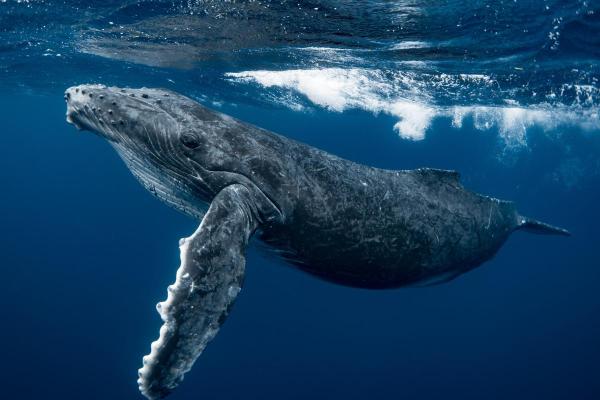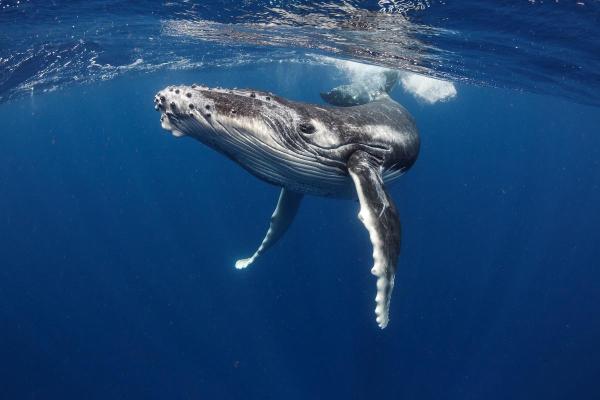
The blue whale (Balaenoptera musculus) is the largest living creature on the planet. A true colossus of the oceans, there are individuals which exceed 110 ft (33.5 m) in length and weigh over 100,000 lb. Their enormous size does not mean they are free from danger. With the impacts of climate change, ocean pollution and other global factors, there are threats to whale populations all over the world. This leads AnimalWised to ask is the blue whale an endangered species?
The sad truth is that yes, blue whales are endangered. We explain the reasons why blue whale populations are under threat and what possible conservation efforts can help restore their security in marine ecosystems.
Is the blue whale endangered?
Yes, the blue whale is endangered. According to the International Union for Conservation of Nature (IUCN), the blue whale has been classified as an endangered species for decades. Although its population has shown some recovery since the ban on commercial whaling in 1966, its numbers remain critically low.
In 2024, it is estimated that only between 10,000 and 25,000 blue whales remain in the world's oceans. This figure represents only a fraction of their historic population, which was estimated at more than 350,000 before the era of intensive hunting. The recovery of this whale species is slow. This is due to their low reproductive rate and the multiple threats they currently face.
Before we examine in detail the reasons why the blue whale is an endangered species, you may want to learn some more background information with our article sharing interesting facts about blue whales.

Reasons why the blue whale is endangered
Despite being the largest animal in the world, the blue whale has faced existential threats. While recent issues with marine pollution and climate change have exacerbated these threats, they began long before. Technological advances in the 19th century allowed the commercial whaling industry to decimate blue whale populations, reducing their numbers to around 10% of their pre-whaling numbers.
Although commercial whaling for blue whales was banned worldwide in 1966, other threats has meant these numbers have never really recovered. There are also likely incidents of blue whale deaths which go unreported[1]. We understand why by looking at the reasons why the blue whale is an endangered species:
- Historical commercial whaling: during the 19th and 20th centuries, intensive hunting of blue whales for their blubber and meat drastically reduced their population. This practice was banned in 1966 by the International Whaling Commission (IWC), but the damage had been done and, combined with other factors, populations have struggling to increase.
- Ship strikes: maritime traffic in areas where blue whales live poses a significant danger. Collisions with large vessels can cause serious injury or death to these mammals.
- Noise pollution: underwater noise generated by ships, military sonars and oil exploration activities interferes with the communication of blue whales. They rely on sound to navigate, find food and mate.
- Climate change: global warming affects the availability of krill (a small crustacean), the main food of blue whales. Rising ocean temperatures alter marine ecosystems, reducing krill populations. Discover how global warming affects the diet of other marine animals with our article sharing the penguin's diet.
- Chemical pollution: pollutants such as plastics and toxic chemicals accumulate in the oceans, affecting the health of whales and their reproductive capacity.
- Entanglement in fishing nets: although blue whales are not targeted by commercial fishing, they can be affected by it. Especially with larger whales, the animal can become entangled in fishing nets which can lead to injury or death.
Combined with human impact factors such as commercial fishing, climate change and pollution, blue whale populations have struggling to recover after whaling was band due to a slow reproductive rate. They can only have one calf every five years or so with a gestation period of up to 12 months. Despite a long lifespan, this only allows for a slow recovery of populations.
Learn more about the baleen life expectancy with our article asking how long do whales live?

How to prevent the extinction of the blue whale
Protecting the blue whale requires coordinated efforts at a global level. Here are some key measures to prevent its extinction:
- Strengthen protection laws: maintaining and reinforcing international bans on whaling is essential. In addition, marine protected areas should be established where blue whales can feed and reproduce without threats. Enforcing penalties for contravention of these laws is also important.
- Reducing shipping traffic in critical areas: implementing alternative shipping routes and speed limits in areas where blue whales live can reduce the risk of collisions.
- Controlling noise pollution: regulating the use of military sonars and other sources of underwater noise can help protect the natural communication and behavior of blue whales.
- Combating climate change: reducing greenhouse gas emissions is essential to protect marine ecosystems and ensure food availability for blue whales.
- Promote sustainable fisheries: implement fishing practices that minimize the risk of entanglement and reduce incidental catch of non-target species.
- Education and awareness: informing the public about the importance of conserving blue whales and oceans can encourage greater support for conservation initiatives.
- Research and monitoring: continue studying blue whales to better understand their needs and threats. Constant monitoring of their populations is crucial to assess the success of conservation measures.
While the blue whale is the largest mammal ever recorded, you may want to learn about other huge marine species with our article sharing the largest whales and their sizes.

If you want to read similar articles to Is the Blue Whale an Endangered Species?, we recommend you visit our Endangered animals category.
1. Aguilar, A., & Borrell, A. (2022). Unreported catches, impact of whaling and current status of blue whales in the South European Atlantic Shelf. Scientific reports, 12(1), 5491.
https://doi.org/10.1038/s41598-022-09570-6
- Cooke, J. G. (2018). Balaenoptera musculus (errata version published in 2019). The IUCN Red List of Threatened Species 2018: e.T2477A156923585.
https://dx.doi.org/10.2305/IUCN.UK.2018-2.RLTS.T2477A156923585 - De Vos, A., Brownell Jr, R.L., Tershy, B., & Croll, D. (2016). Anthropogenic threats and conservation needs of blue whales, Balaenoptera musculus indica, around Sri Lanka. Journal of Marine Sciences, 2016(1), 8420846.
- Laggner, D. (2009). Blue Whale (Baleanoptera Musculus) Ship Strike Threat Assessment in the Santa Barbara Channel, California (Doctoral dissertation, Evergreen State College).
- Lesage, V., Gosselin, JF, Lawson, JW, McQuinn, I., Moors-Murphy, H., Plourde, S., ... & Simard, Y. (2018). Habitats important to blue whales (Balaenoptera musculus) in the western North Atlantic. Canadian Science Advisory Secretariat (CSAS).